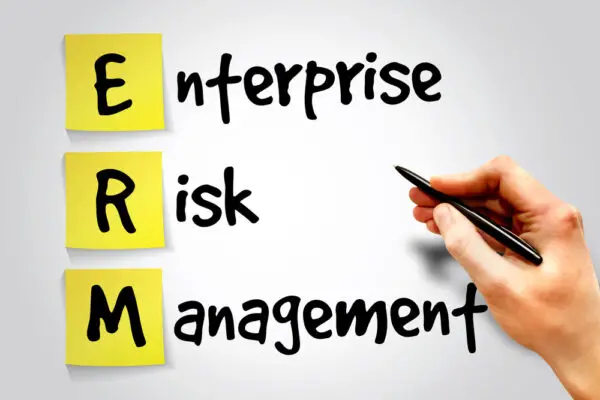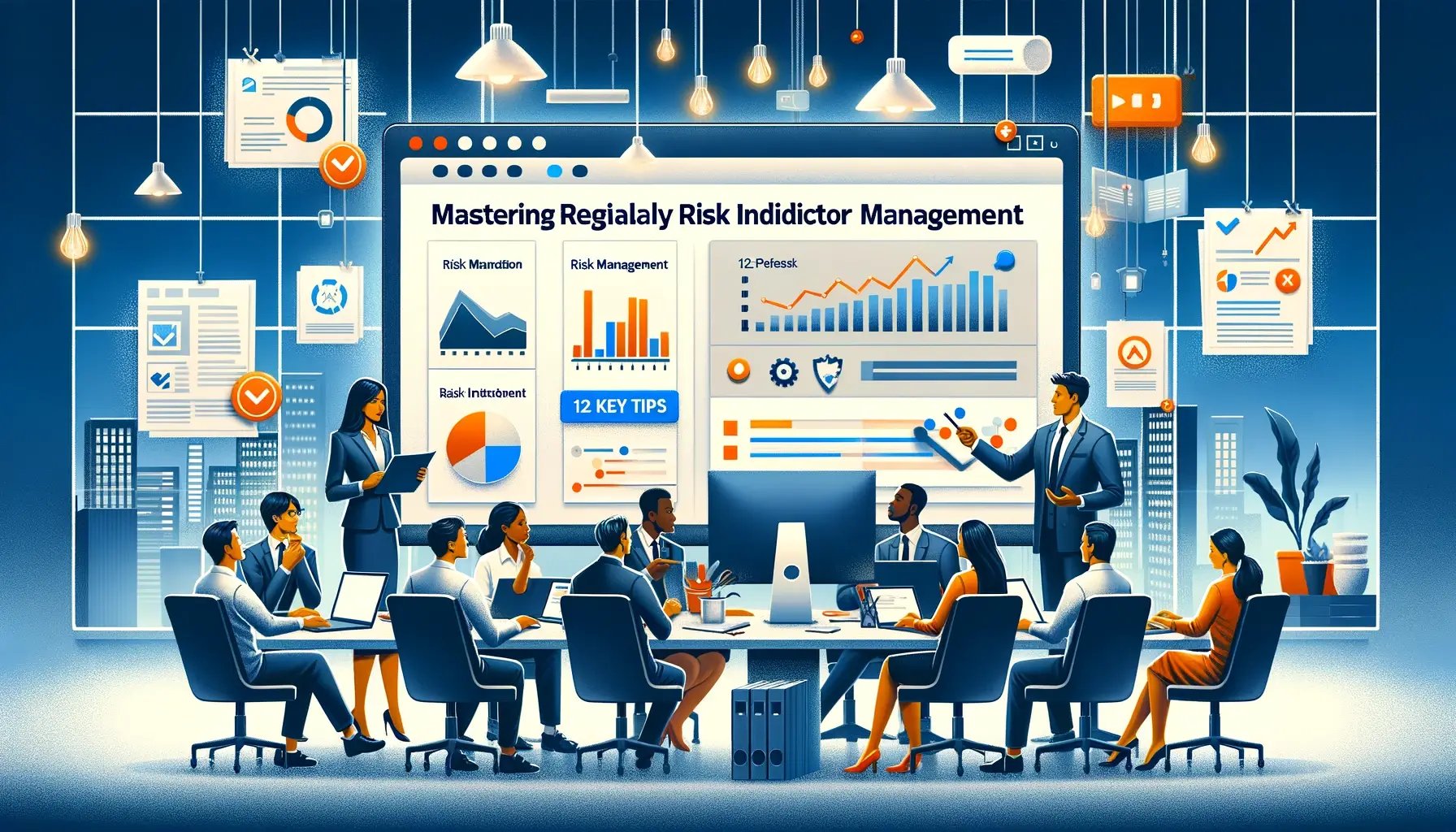Regulatory risk management is a critical aspect of any business, particularly for those in the financial sector. With constantly changing regulations and compliance requirements, it can be challenging to keep up with the latest developments and ensure that your business is meeting all the necessary standards.
However, mastering regulatory risk indicator management is essential to avoid costly fines, reputational damage, and other negative consequences.
To help businesses navigate this complex landscape, a comprehensive guide has been developed that provides twelve essential tips for mastering regulatory risk indicator management.
These tips cover a range of topics, including understanding key regulatory requirements, developing policies and procedures, and implementing effective risk management strategies.
Businesses can ensure full compliance by following these tips.
Whether you are just starting out in the financial sector or are an experienced professional looking to enhance your regulatory risk management skills, this guide is an excellent resource.
With expert advice and practical tips, this guide provides businesses with a comprehensive overview of key strategies and best practices to stay ahead and avoid costly mistakes.
So why wait? Start mastering regulatory risk indicator management today and take your business to the next level!
Understanding Regulatory Risk Indicator Management
Regulatory Risk Indicator Management is a process that helps organizations measure the level of regulatory and risk management pressures they face.
It is a vital tool for organizations to gauge and mitigate potential risks in the realm of regulatory compliance.
The Regulatory and Risk Management Indicator (RRMI) is a survey that measures trend information on regulatory and risk concerns, realized and anticipated regulatory impacts on institutions, and the level of banks’ current risk management efforts.
The RRMI measures ten critical factors that help illustrate the overall level of regulatory and risk management pressures that U.S. banks and credit unions face.
Regulatory risk management is a process that involves identifying, assessing, and managing the risks associated with regulatory compliance.
It involves understanding the regulatory environment, identifying the regulatory requirements that apply to the organization, and developing compliance programs to ensure that the organization meets those requirements.
Regulations are an important part of regulatory risk management. They are rules that regulatory agencies create to implement laws passed by the government.

Regulations can cover a wide range of topics, from environmental protection to financial reporting.
Risks are inherent in any business, and regulatory risks are no exception. Regulatory risks can arise from a variety of sources, including changes in regulations, failure to comply with existing regulations, and enforcement actions by regulatory agencies.
Effective regulatory risk management requires a comprehensive approach that includes identifying and assessing risks, developing strategies to mitigate those risks and monitoring and reporting on the effectiveness of those strategies.
Organizations that master regulatory risk indicator management can improve their compliance efforts, reduce the risk of regulatory violations, and enhance their overall risk management practices.
Identifying and Assessing Risks
The first step in mastering regulatory risk indicator management is to identify and assess risks. This involves understanding the organization’s objectives, processes, and activities and identifying potential risks that could impact the achievement of those objectives.
To identify risks, the organization should consider both internal and external factors that could affect its operations. Internal factors may include changes in personnel, processes, or technology, while external factors may include changes in the regulatory environment, market conditions, or geopolitical risks.
Once risks have been identified, they should be assessed to determine their likelihood and potential impact. This can be done through a risk assessment process that involves analyzing the risk exposure of each identified risk and prioritizing them based on their likelihood and potential impact.
The risk exposure of each identified risk can be assessed by considering factors such as the likelihood of the risk occurring, the potential impact of the risk, and the effectiveness of existing controls in mitigating the risk.
This information can be documented in a risk register, which can be used to track the organization’s risk profile over time.
To ensure that risks are properly assessed, the organization should involve key stakeholders in the process, including senior management, risk managers, and subject matter experts.
This will help to ensure that all relevant risks are identified and assessed and that the risk assessment process is transparent and objective.
Identifying and assessing risks is a critical first step in mastering regulatory risk indicator management. Organizations can develop effective risk management strategies by systematically identifying and assessing potential risks.
Monitoring and Reporting Risks
One of the most critical aspects of regulatory risk management is monitoring and reporting risks. Organizations must comprehensively understand their risk profile to manage regulatory risks effectively.
This includes identifying and assessing risks, monitoring, and reporting on risk exposure, and implementing effective risk mitigation strategies.
Risk monitoring involves the continuous tracking of key risk indicators (KRIs) to identify emerging risks and potential issues.
KRIs are data-driven insights that provide business intelligence on the organization’s risk profile. Organizations can rapidly identify and address potential issues by monitoring key risk indicators (KRIs).
Reporting on risks is an essential component of regulatory risk management. Organizations must provide accurate and timely information to regulators, stakeholders, and senior management on their risk exposure. This includes regular reporting on risk metrics, risk appetite, and risk mitigation strategies.
Organizations must have robust risk management processes to effectively monitor and report on risks. This includes a risk governance framework, risk appetite statement, and risk management policies and procedures.
Organizations must also have a comprehensive risk reporting framework that includes regular reporting to senior management, the board of directors, and regulators.
Effective regulatory risk management requires a comprehensive approach to monitoring and reporting risks.
Organizations can proactively manage risks by implementing robust risk management processes and reporting frameworks to understand their risk profile better.
Role of Technology in Risk Management
Technology has played a significant role in risk management, enabling organizations to manage risks more efficiently and effectively.
The introduction of automation, artificial intelligence, and other technological advancements has made the process of identifying, assessing, and managing risks more efficient and accurate.
One of the key benefits of technology in risk management is the ability to automate the process of collecting and analyzing data.
This allows organizations to identify potential risks in real-time and take corrective action before they become major issues.
Organizations can leverage technology to identify patterns and trends in data, enabling them to make more informed decisions regarding risk management.
Artificial intelligence (AI) is another technology that is transforming risk management. AI can be used to analyze large amounts of data and identify potential risks that may have gone unnoticed otherwise.
AI can also be used to predict future trends and identify potential risks before they become major issues.
In addition to automating and streamlining the risk management process, technology can also improve communication and collaboration between different departments within an organization.
This can help ensure that everyone is on the same page when it comes to risk management and that potential risks are identified and addressed in a timely manner.

Technology has become an essential tool in risk management, enabling organizations to manage risks more efficiently and effectively.
As technology continues to evolve, it is likely that we will see even more advancements in risk management, making it easier for organizations to identify and manage risks in real-time.
Key Risk Indicators (KRIs)
Key Risk Indicators (KRIs) are measurable values that are used to monitor and manage potential risks in an organization. KRIs are an essential component of an effective risk management strategy.
They serve as an early warning system, alerting organizations to emerging risks before they become bigger, more complicated concerns. KRIs can help organizations proactively identify, monitor, and manage potential risks.
KRI design is critical to the success of any risk management program. KRIs should be specific, measurable, and relevant to the organization’s objectives and risk appetite.
They should also be aligned with the organization’s overall risk management strategy. The design of KRIs should be based on a thorough understanding of the organization’s business processes, risk profile, and risk management objectives.
Effective KRI design involves identifying the right metrics to measure, setting appropriate thresholds, and ensuring that the data used to calculate the KRIs is accurate and timely.
KRIs should be designed to provide meaningful insights into the organization’s risk exposure and should be easy to understand and interpret.
KRIs are an essential tool for effective risk management. They provide organizations with a proactive approach to identifying, monitoring, and managing potential risks.
Effective KRI design is critical to the success of any risk management program. KRIs should be specific, measurable, and relevant to the organization’s objectives and risk appetite.
Compliance and Risk Mitigation
Compliance and risk mitigation are essential components of regulatory risk indicator management. Compliance refers to the adherence to laws, regulations, and guidelines that govern an industry or organization.
Compliance risks are the potential risks that arise from non-compliance with these laws, regulations, and guidelines. Organizations must manage these risks to ensure compliance and avoid penalties and reputational damage.
Compliance management involves the identification, assessment, and mitigation of compliance risks. Organizations must have a compliance management program that outlines policies, procedures, and controls to manage these risks. This program should be regularly reviewed and updated to ensure its effectiveness.
Compliance monitoring is the process of monitoring an organization’s compliance with laws, regulations, and guidelines.
This process involves the collection, analysis, and reporting of compliance data. Organizations must have a robust compliance monitoring program that includes regular audits, testing, and reporting to ensure compliance.
To mitigate compliance risks, organizations must adopt a risk-based approach. This approach involves identifying and prioritizing compliance risks based on their potential impact on the organization.
Organizations must then develop and implement controls to mitigate these risks.
Some examples of controls that organizations can implement to mitigate compliance risks include:
- Developing policies and procedures to ensure compliance with laws, regulations, and guidelines.
- Providing training and awareness programs to employees to ensure they understand their compliance obligations.
- Conducting regular audits and assessments to identify compliance gaps and areas for improvement.
- Implementing technology solutions to automate compliance processes and reduce the risk of human error.
- Establishing a compliance culture that promotes ethical behaviour and compliance with laws, regulations, and guidelines.
Organizations can ensure compliance by adopting a risk-based approach and implementing effective controls.
Regulatory Compliance and Change Management
Regulatory compliance and change management are two critical components of the regulatory risk management process.
Regulatory compliance refers to the process of ensuring that a company adheres to all relevant laws, regulations, and standards that govern its operations.
Change management, on the other hand, is the process of managing changes to a company’s operations, processes, and systems.
Effective regulatory compliance and change management require a well-defined regulatory strategy that outlines how a company will identify, assess, and manage regulatory risks.
This strategy should include a clear definition of the company’s regulatory obligations, a process for monitoring regulatory changes, and a plan for implementing changes to ensure ongoing compliance.
One of the key challenges of regulatory compliance and change management is keeping up with the ever-changing regulatory landscape.
As new regulations are introduced and existing regulations are updated, companies must be able to quickly adapt their operations, processes, and systems to remain compliant.
This requires a proactive approach to regulatory risk management that includes ongoing monitoring of regulatory developments and a process for assessing the impact of these developments on the company’s operations.
To effectively manage regulatory compliance and change management, companies should consider implementing the following best practices:
- Develop a comprehensive regulatory compliance program that includes policies, procedures, and controls to ensure ongoing compliance with all relevant regulations and standards.
- Establish a change management process that includes a clear definition, a process for assessing the impact of changes on the company’s operations, and a plan for implementing changes to ensure ongoing compliance.
- Implement a regulatory change management system that includes a centralized repository for tracking regulatory changes, a process for assessing the impact of these changes on the company’s operations, and a plan for implementing changes to ensure ongoing compliance.
- Conduct regular training and awareness programs to ensure that employees are aware of their regulatory obligations and understand how to comply with them.
- Establish a process for monitoring regulatory developments and assessing the impact of these developments on the company’s operations.
- Ensure that the company’s operations, processes, and systems are designed to be flexible and adaptable to changes in the regulatory landscape.
- Regularly review and update the company’s regulatory compliance program and change management process to ensure that they remain effective and up-to-date.
Companies can effectively manage regulatory compliance and change management, reduce regulatory risk exposure, and ensure ongoing compliance with relevant regulations and standards by implementing best practices.
Operational Risks and Management
Operational risk is the risk of loss resulting from inadequate or failed internal processes, people and systems, or external events.
To manage operational risk, organizations need to have a comprehensive risk management framework that includes identifying, assessing, monitoring, and mitigating risks.
One important tool within risk management is the use of key risk indicators (KRIs).
KRIs are measures that provide insights into the risk profile and aid in crafting a comprehensive risk management strategy.
They are instrumental in managing risks over a period of time, impacting employee retention, financial impact, and reputational risks. KRIs can also be used to enhance the monitoring and mitigation of risks and facilitate risk reporting.
Enterprise risk management (ERM) is a holistic approach to managing risks across an organization. It involves identifying risks, assessing their potential impact, and implementing strategies to mitigate those risks.
ERM can help organizations to understand their risk profile better and to develop a more effective risk management strategy.
To effectively manage operational risks, organizations need to have a strong risk management framework that incorporates KRIs and ERM.
This framework should be supported by a culture of risk awareness and a commitment to continuous improvement. Organizations can minimize operational risks and better respond to threats.
Performance Indicators and Benchmarking
One of the most important aspects of regulatory risk indicator management is the use of performance indicators (KPIs) and benchmarking.
These tools enable organizations to measure and evaluate their regulatory compliance and risk management efforts against industry standards and best practices.
KPIs are specific data points or metrics that organizations use to monitor and assess potential risks that may impact their operations, financial health, or overall performance.
Organizations can gain valuable insights into regulatory compliance and risk management by identifying and tracking KPIs, enabling informed decisions for improvement.
Benchmarking is the process of comparing an organization’s performance against that of its peers or industry standards.
Comparing their regulatory compliance and risk management efforts with similar organizations, companies can identify and address areas lacking.
Some common KPIs and benchmarking metrics used in regulatory risk indicator management include:
- Compliance costs: the total cost of compliance activities, including personnel, technology, and other resources.
- Compliance efficiency: the ratio of compliance costs to the number of compliance activities completed.
- Compliance effectiveness: the percentage of compliance activities completed successfully.
- Risk exposure: the potential impact of a risk event on the organization’s financial health or reputation.
- Risk mitigation: the effectiveness of the organization’s risk management efforts in reducing risk exposure.
Organizations can improve regulatory compliance and risk management through performance indicators and benchmarking.
Role of Senior Management and Decision-Making
Senior management plays a crucial role in the management of regulatory risks. They are responsible for making strategic decisions that impact the organization’s regulatory risk exposure.
Senior management should ensure that the organization’s risk management framework is robust and effective in managing regulatory risks.
One of the key responsibilities of senior management is to establish a risk culture that promotes risk awareness and accountability throughout the organization.
They should ensure that all employees understand the organization’s risk appetite and are aware of their role in managing regulatory risks.
Senior management should also ensure that the organization has a clear and effective process for identifying, assessing, and prioritizing regulatory risks.
This process should involve all relevant stakeholders and should be based on a thorough understanding of the organization’s operations and regulatory environment.
In addition to establishing a risk management framework, senior management should also ensure that the organization has a clear and effective process for decision-making. This process should be based on a thorough analysis of the risks and benefits associated with each decision.
Effective decision-making requires a clear understanding of the organization’s risk appetite and a thorough analysis of the risks associated with each decision.
Senior management should ensure that all decision-makers are provided with the necessary information and tools to make informed decisions that are consistent with the organization’s risk appetite.
Senior management plays a critical role in managing regulatory risks. They are responsible for establishing a risk management framework, promoting a risk culture, and ensuring that the organization has a clear and effective process for decision-making.
Effective management of regulatory risks requires a collaborative effort between senior management, decision-makers, and all relevant stakeholders.

Impact on Customer Experience
Effective regulatory risk management not only helps banks and financial institutions avoid costly penalties but it also impacts customer experience and satisfaction.
Compliance with regulations protects customers from fraud, money laundering, and other financial crimes. This creates a sense of trust between customers and financial institutions, which is essential for customer retention.
When banks prioritize regulatory compliance and risk management, they can streamline processes and reduce the number of hand-offs, leading to a better customer experience.
According to a McKinsey report, banks that streamlined processes and reduced the number of hand-offs saw significant benefits in risk effectiveness and customer experience. They reduced the number of cases in the second line of defense and returned to the first line of defence by 61%. They also lowered the response time to requests for information by 17%.
Moreover, banks that prioritize regulatory compliance can also use it as a competitive advantage. By ensuring that they are compliant with regulations, they can differentiate themselves from their competitors and attract customers who value security and trust. This can lead to increased customer satisfaction and loyalty.
Regulatory compliance and risk management are essential for banks and financial institutions to maintain customer trust and satisfaction.
Prioritizing regulatory compliance can help banks streamline processes, reduce hand-offs, and improve customer experience.
Future Trends and Forward-Looking Strategies
Regulatory risk management is an ever-evolving field that requires constant adaptation to stay ahead of the curve. As such, it is essential to keep an eye on future trends and forward-looking strategies to ensure regulatory compliance and minimize risk.
One of the most significant trends in regulatory risk management is the shift towards forward-looking, predictive indicators.
Rather than relying solely on historical data, organizations are increasingly using leading indicators to anticipate and mitigate potential future risks. These indicators can include a range of factors, such as economic trends, emerging technologies, and geopolitical events.
To effectively leverage forward-looking indicators, it is essential to have a robust data analytics infrastructure in place. This includes collecting and analyzing data from a range of sources, including internal systems, external market data, and social media.
Organizations can uncover hidden patterns and trends using advanced analytics techniques like machine learning and natural language processing.
Another critical strategy for managing regulatory risk is to ensure relevance. As regulations and market conditions change, it is essential to regularly review and update risk indicators to ensure they remain relevant and effective.
This includes engaging with stakeholders such as regulators, industry groups, and customers to understand their evolving needs and concerns.
To stay ahead of the curve, organizations should also consider adopting a risk management framework that incorporates emerging technologies such as blockchain, artificial intelligence, and the Internet of Things.
These technologies can provide new insights into risk management and enable more effective risk mitigation strategies.
Regulatory risk management is a constantly evolving field that requires organizations to stay ahead of the curve. Organizations can effectively manage regulatory risk by adopting emerging technologies, ensuring relevance and leveraging forward-looking indicators.

Chris Ekai is a Risk Management expert with over 10 years of experience in the field. He has a Master’s(MSc) degree in Risk Management from University of Portsmouth and is a CPA and Finance professional. He currently works as a Content Manager at Risk Publishing, writing about Enterprise Risk Management, Business Continuity Management and Project Management.

